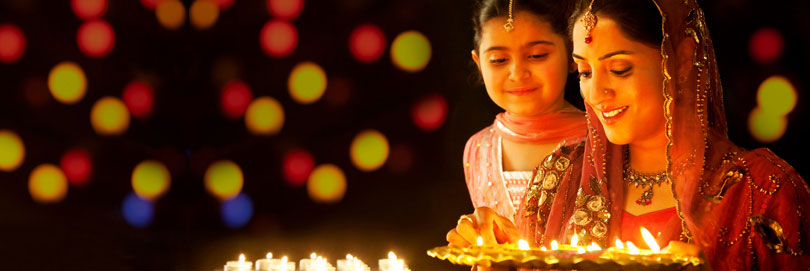Diwali in West Bengal

| Diwali Celebration in West Bengal | ||||||||
|
In West Bengal, Lakshmi puja is celebrated five days after Dussehra, on the full moon day (Purnima). On the following new moon day (Amavasya), coinciding with Diwali, goddess Kali is worshiped. Kali, the more aggressive form or the destructive incarnation of Goddess Durga, has a terrifying look. She destroys all evils. Lamps are lit in her honor, and in return, she promises a renewal of life and justice on earth.
In West Bengal, it is not Lakshmi puja but Kali Puja which makes the festival unique. Kali is generally a goddess to be feared rather than venerated. But, Diwali is also celebrated with great enthusiasm and it is a time for gaiety and feasting. The houses are decorated and lit with diyas. Two or even four plantain leaves decorate the entry to the house or property, with a row of diyas at the doorstep. The entire family gathers around for Lakshmi puja in the evening.
Diwali Festival stretches over three days, but on Amavasya the final day, the celebrations and lights are less. The first two festival days are important, with feasting, drinking, gambling, family gatherings, lights and fire crackers occupying time from dusk to dawn. In West Bengal, the pious festive air and not the material goods, mainly marks the occasion. No new clothes, no new utensils, no new gold. In fact nothing new at all on Diwali day, as all the shops are shut tight except those selling sweets and fire crackers. Gifts are limited to sweets and dry fruits.
Assam | Bihar | Delhi | Gujarat | Jammu and Kashmir | Orissa | Rajasthan
Punjab | West Bengal | Uttar Pradesh | Himachal Pradesh
- - Diwali Cards
- - Crackers
- - Dry Fruits
Festival Fun
- Diwali Rangoli
- Diwali Whatsapp Messages/Status
- Diwali Recipes
- Deep in Diwali
- Tradition of Playing Cards
- Pooja Thali Decorations
- Making Diwali Cards
- Diwali Essay
- Diwali Poems
- Diwali Songs
- Diwali Mela
- Diwali Wallpapers
- Diwali Decorative Items
- Diwali 2024
- Diwali Messages
- Diwali Quotes
- Lakshmi Pooja
- Articles
- Lakshmi Ganesha Mantras
- Lakshmi Chalisa
- Diwali SMS
- Diwali Solar Eclipse
- Diwali Remedies
- 108 Lakshmi Names
Diwali Rangoli
Indians love colors and its perfectly reflected in various ways. Rangoli is one such example that is a unique art work that is...Know More
Diwali in History
The history of Diwali is replete with legends and these legends are moored to the stories of Hindu religious scriptures...Know More
Diwali Messages
Enjoy the Best and the Most Heartfelt Diwali Messages from all entries received by us!!...Know More
Diwali Gift Ideas
Diwali is the epiphany of showing gratefulness to the almighty for blessing with wealth and wisdom. It is the time of illuminating...Know More





